Analysis of Intersectionality and Gendered Dress Code Policies
VerifiedAdded on 2020/12/09
|11
|3656
|151
Report
AI Summary
This report examines the intersection of law, intersectionality, and dress codes, focusing on gender discrimination and equality. It begins with an introduction to the concept of law and the relevance of intersectionality in addressing societal inequalities, particularly concerning dress code policies. The main body includes secondary data analysis, exploring existing literature, legal frameworks, and real-world examples of discrimination. Element B focuses on creating an educational toolkit, suggesting games and activities to raise awareness and change attitudes towards dress codes within organizations. The report then presents a literature review and reflection, summarizing key findings and offering insights into the complexities of the issue. The conclusion synthesizes the analysis, emphasizing the importance of equitable dress code policies and the need for continued efforts to combat discrimination. The report also references relevant legislation like the Equality Act 2010 and provides examples of how organizations can address gender-based dress code disparities. The report aims to provide a comprehensive understanding of the legal and social implications of dress codes, offering practical solutions for promoting equality and inclusivity.
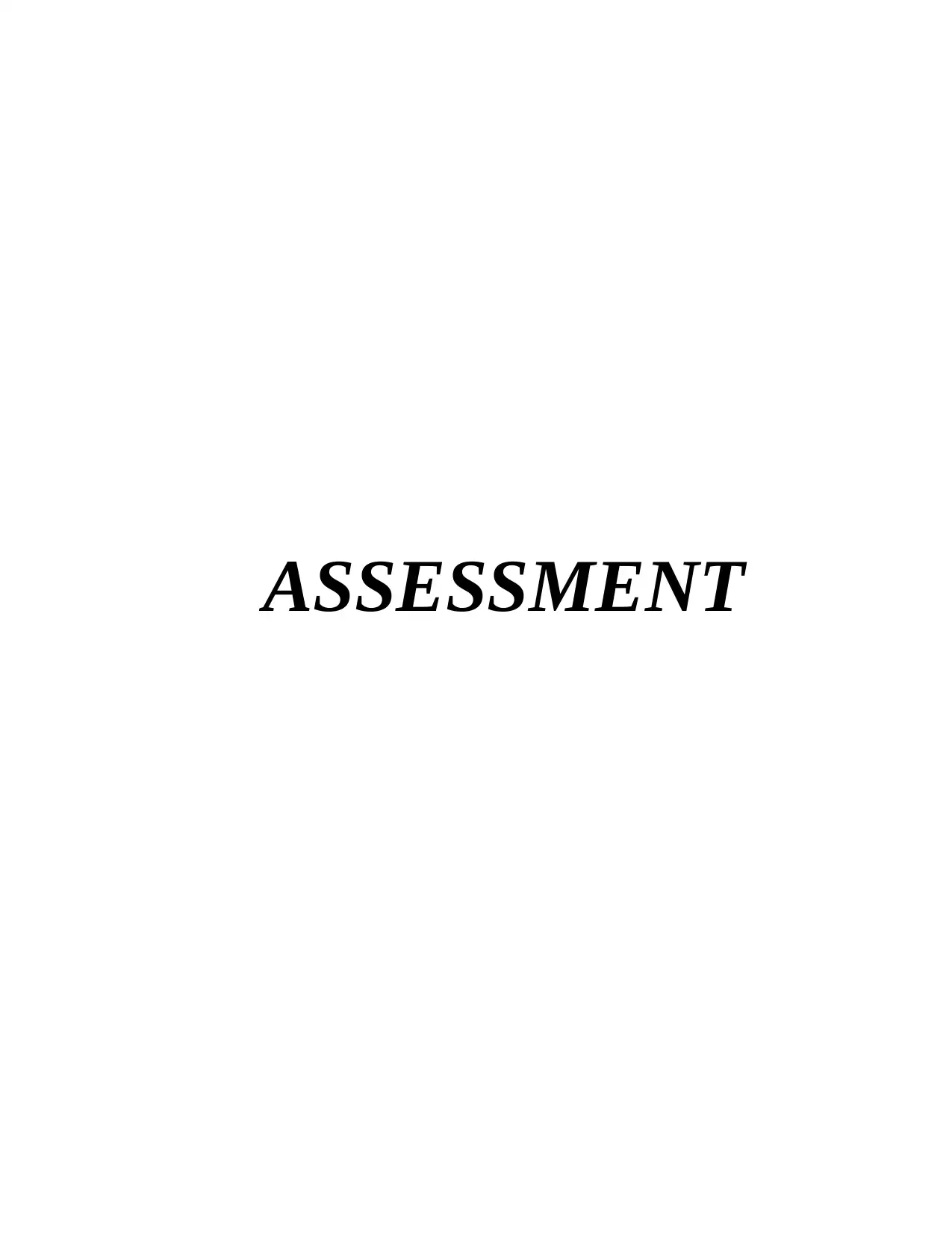
ASSESSMENT
Paraphrase This Document
Need a fresh take? Get an instant paraphrase of this document with our AI Paraphraser
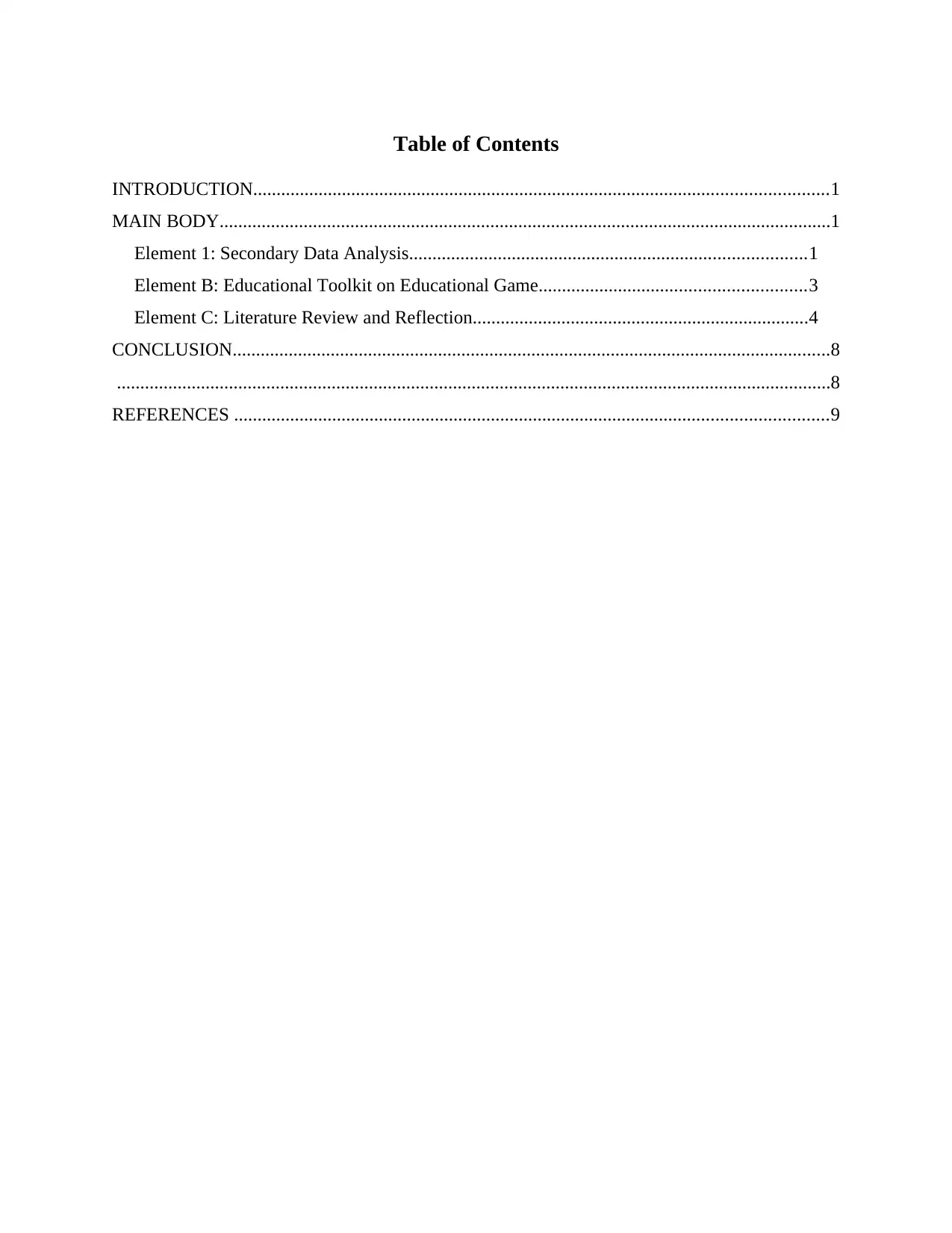
Table of Contents
INTRODUCTION...........................................................................................................................1
MAIN BODY...................................................................................................................................1
Element 1: Secondary Data Analysis.....................................................................................1
Element B: Educational Toolkit on Educational Game.........................................................3
Element C: Literature Review and Reflection........................................................................4
CONCLUSION................................................................................................................................8
.........................................................................................................................................................8
REFERENCES ...............................................................................................................................9
INTRODUCTION...........................................................................................................................1
MAIN BODY...................................................................................................................................1
Element 1: Secondary Data Analysis.....................................................................................1
Element B: Educational Toolkit on Educational Game.........................................................3
Element C: Literature Review and Reflection........................................................................4
CONCLUSION................................................................................................................................8
.........................................................................................................................................................8
REFERENCES ...............................................................................................................................9
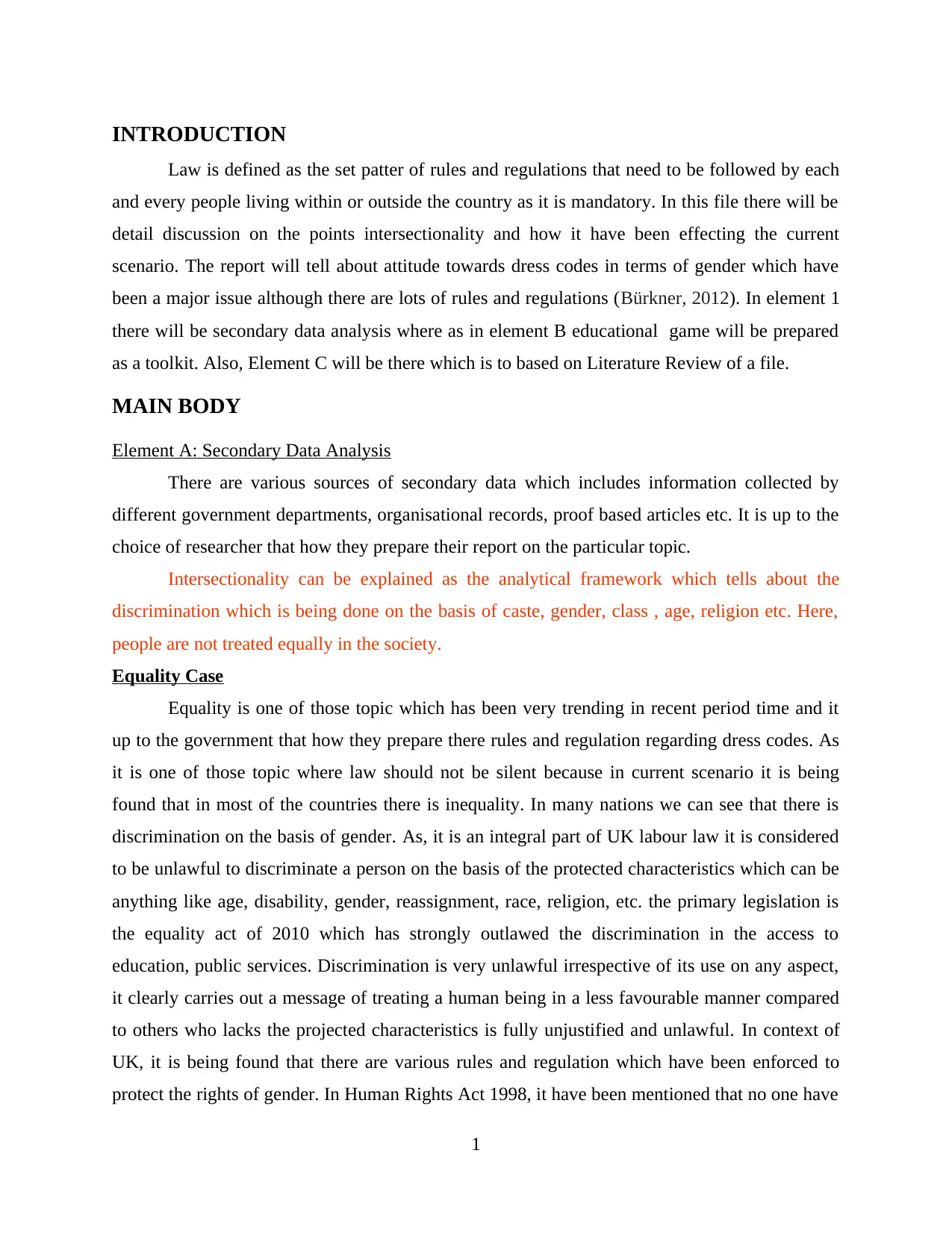
INTRODUCTION
Law is defined as the set patter of rules and regulations that need to be followed by each
and every people living within or outside the country as it is mandatory. In this file there will be
detail discussion on the points intersectionality and how it have been effecting the current
scenario. The report will tell about attitude towards dress codes in terms of gender which have
been a major issue although there are lots of rules and regulations (Bürkner, 2012). In element 1
there will be secondary data analysis where as in element B educational game will be prepared
as a toolkit. Also, Element C will be there which is to based on Literature Review of a file.
MAIN BODY
Element A: Secondary Data Analysis
There are various sources of secondary data which includes information collected by
different government departments, organisational records, proof based articles etc. It is up to the
choice of researcher that how they prepare their report on the particular topic.
Intersectionality can be explained as the analytical framework which tells about the
discrimination which is being done on the basis of caste, gender, class , age, religion etc. Here,
people are not treated equally in the society.
Equality Case
Equality is one of those topic which has been very trending in recent period time and it
up to the government that how they prepare there rules and regulation regarding dress codes. As
it is one of those topic where law should not be silent because in current scenario it is being
found that in most of the countries there is inequality. In many nations we can see that there is
discrimination on the basis of gender. As, it is an integral part of UK labour law it is considered
to be unlawful to discriminate a person on the basis of the protected characteristics which can be
anything like age, disability, gender, reassignment, race, religion, etc. the primary legislation is
the equality act of 2010 which has strongly outlawed the discrimination in the access to
education, public services. Discrimination is very unlawful irrespective of its use on any aspect,
it clearly carries out a message of treating a human being in a less favourable manner compared
to others who lacks the projected characteristics is fully unjustified and unlawful. In context of
UK, it is being found that there are various rules and regulation which have been enforced to
protect the rights of gender. In Human Rights Act 1998, it have been mentioned that no one have
1
Law is defined as the set patter of rules and regulations that need to be followed by each
and every people living within or outside the country as it is mandatory. In this file there will be
detail discussion on the points intersectionality and how it have been effecting the current
scenario. The report will tell about attitude towards dress codes in terms of gender which have
been a major issue although there are lots of rules and regulations (Bürkner, 2012). In element 1
there will be secondary data analysis where as in element B educational game will be prepared
as a toolkit. Also, Element C will be there which is to based on Literature Review of a file.
MAIN BODY
Element A: Secondary Data Analysis
There are various sources of secondary data which includes information collected by
different government departments, organisational records, proof based articles etc. It is up to the
choice of researcher that how they prepare their report on the particular topic.
Intersectionality can be explained as the analytical framework which tells about the
discrimination which is being done on the basis of caste, gender, class , age, religion etc. Here,
people are not treated equally in the society.
Equality Case
Equality is one of those topic which has been very trending in recent period time and it
up to the government that how they prepare there rules and regulation regarding dress codes. As
it is one of those topic where law should not be silent because in current scenario it is being
found that in most of the countries there is inequality. In many nations we can see that there is
discrimination on the basis of gender. As, it is an integral part of UK labour law it is considered
to be unlawful to discriminate a person on the basis of the protected characteristics which can be
anything like age, disability, gender, reassignment, race, religion, etc. the primary legislation is
the equality act of 2010 which has strongly outlawed the discrimination in the access to
education, public services. Discrimination is very unlawful irrespective of its use on any aspect,
it clearly carries out a message of treating a human being in a less favourable manner compared
to others who lacks the projected characteristics is fully unjustified and unlawful. In context of
UK, it is being found that there are various rules and regulation which have been enforced to
protect the rights of gender. In Human Rights Act 1998, it have been mentioned that no one have
1
⊘ This is a preview!⊘
Do you want full access?
Subscribe today to unlock all pages.

Trusted by 1+ million students worldwide
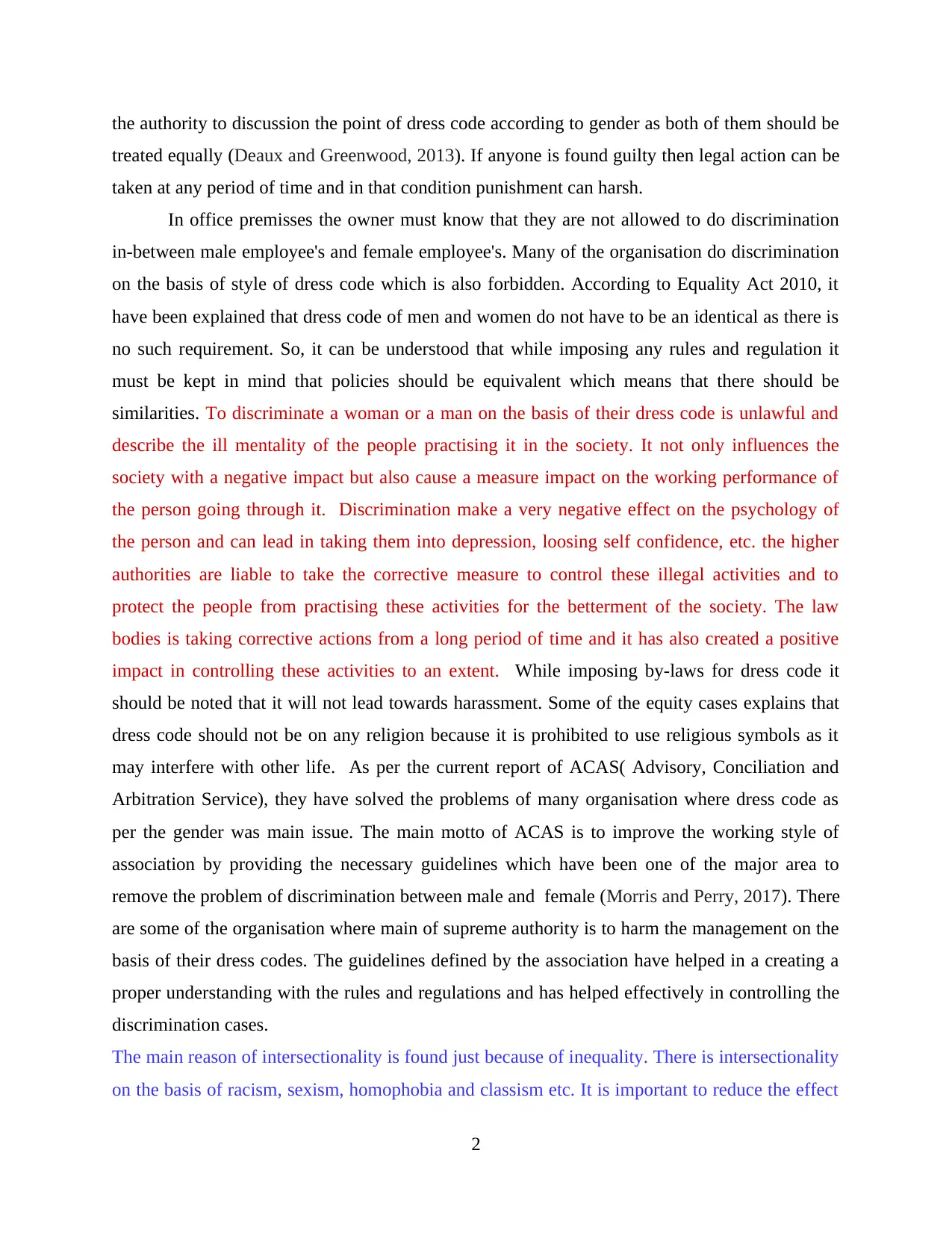
the authority to discussion the point of dress code according to gender as both of them should be
treated equally (Deaux and Greenwood, 2013). If anyone is found guilty then legal action can be
taken at any period of time and in that condition punishment can harsh.
In office premisses the owner must know that they are not allowed to do discrimination
in-between male employee's and female employee's. Many of the organisation do discrimination
on the basis of style of dress code which is also forbidden. According to Equality Act 2010, it
have been explained that dress code of men and women do not have to be an identical as there is
no such requirement. So, it can be understood that while imposing any rules and regulation it
must be kept in mind that policies should be equivalent which means that there should be
similarities. To discriminate a woman or a man on the basis of their dress code is unlawful and
describe the ill mentality of the people practising it in the society. It not only influences the
society with a negative impact but also cause a measure impact on the working performance of
the person going through it. Discrimination make a very negative effect on the psychology of
the person and can lead in taking them into depression, loosing self confidence, etc. the higher
authorities are liable to take the corrective measure to control these illegal activities and to
protect the people from practising these activities for the betterment of the society. The law
bodies is taking corrective actions from a long period of time and it has also created a positive
impact in controlling these activities to an extent. While imposing by-laws for dress code it
should be noted that it will not lead towards harassment. Some of the equity cases explains that
dress code should not be on any religion because it is prohibited to use religious symbols as it
may interfere with other life. As per the current report of ACAS( Advisory, Conciliation and
Arbitration Service), they have solved the problems of many organisation where dress code as
per the gender was main issue. The main motto of ACAS is to improve the working style of
association by providing the necessary guidelines which have been one of the major area to
remove the problem of discrimination between male and female (Morris and Perry, 2017). There
are some of the organisation where main of supreme authority is to harm the management on the
basis of their dress codes. The guidelines defined by the association have helped in a creating a
proper understanding with the rules and regulations and has helped effectively in controlling the
discrimination cases.
The main reason of intersectionality is found just because of inequality. There is intersectionality
on the basis of racism, sexism, homophobia and classism etc. It is important to reduce the effect
2
treated equally (Deaux and Greenwood, 2013). If anyone is found guilty then legal action can be
taken at any period of time and in that condition punishment can harsh.
In office premisses the owner must know that they are not allowed to do discrimination
in-between male employee's and female employee's. Many of the organisation do discrimination
on the basis of style of dress code which is also forbidden. According to Equality Act 2010, it
have been explained that dress code of men and women do not have to be an identical as there is
no such requirement. So, it can be understood that while imposing any rules and regulation it
must be kept in mind that policies should be equivalent which means that there should be
similarities. To discriminate a woman or a man on the basis of their dress code is unlawful and
describe the ill mentality of the people practising it in the society. It not only influences the
society with a negative impact but also cause a measure impact on the working performance of
the person going through it. Discrimination make a very negative effect on the psychology of
the person and can lead in taking them into depression, loosing self confidence, etc. the higher
authorities are liable to take the corrective measure to control these illegal activities and to
protect the people from practising these activities for the betterment of the society. The law
bodies is taking corrective actions from a long period of time and it has also created a positive
impact in controlling these activities to an extent. While imposing by-laws for dress code it
should be noted that it will not lead towards harassment. Some of the equity cases explains that
dress code should not be on any religion because it is prohibited to use religious symbols as it
may interfere with other life. As per the current report of ACAS( Advisory, Conciliation and
Arbitration Service), they have solved the problems of many organisation where dress code as
per the gender was main issue. The main motto of ACAS is to improve the working style of
association by providing the necessary guidelines which have been one of the major area to
remove the problem of discrimination between male and female (Morris and Perry, 2017). There
are some of the organisation where main of supreme authority is to harm the management on the
basis of their dress codes. The guidelines defined by the association have helped in a creating a
proper understanding with the rules and regulations and has helped effectively in controlling the
discrimination cases.
The main reason of intersectionality is found just because of inequality. There is intersectionality
on the basis of racism, sexism, homophobia and classism etc. It is important to reduce the effect
2
Paraphrase This Document
Need a fresh take? Get an instant paraphrase of this document with our AI Paraphraser
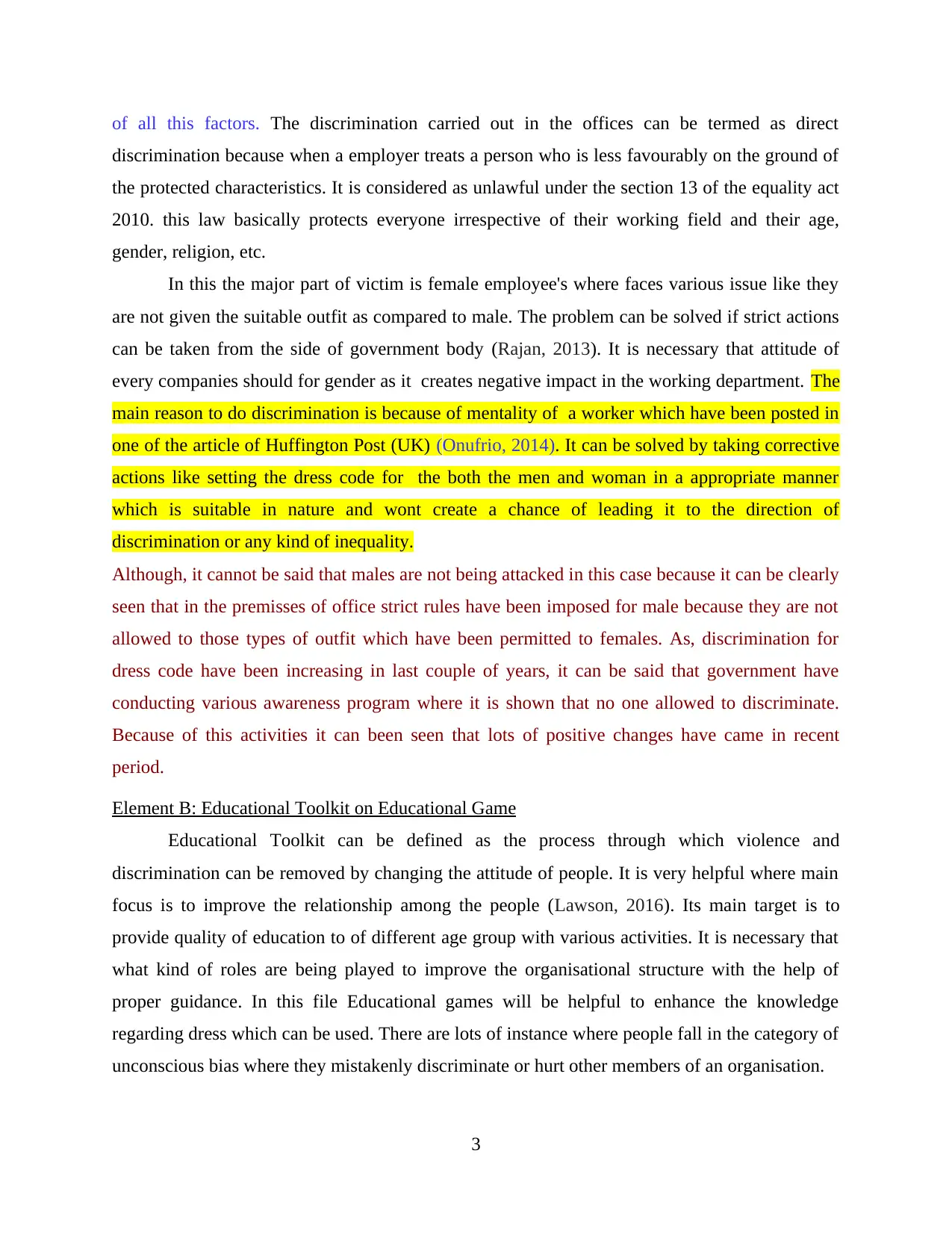
of all this factors. The discrimination carried out in the offices can be termed as direct
discrimination because when a employer treats a person who is less favourably on the ground of
the protected characteristics. It is considered as unlawful under the section 13 of the equality act
2010. this law basically protects everyone irrespective of their working field and their age,
gender, religion, etc.
In this the major part of victim is female employee's where faces various issue like they
are not given the suitable outfit as compared to male. The problem can be solved if strict actions
can be taken from the side of government body (Rajan, 2013). It is necessary that attitude of
every companies should for gender as it creates negative impact in the working department. The
main reason to do discrimination is because of mentality of a worker which have been posted in
one of the article of Huffington Post (UK) (Onufrio, 2014). It can be solved by taking corrective
actions like setting the dress code for the both the men and woman in a appropriate manner
which is suitable in nature and wont create a chance of leading it to the direction of
discrimination or any kind of inequality.
Although, it cannot be said that males are not being attacked in this case because it can be clearly
seen that in the premisses of office strict rules have been imposed for male because they are not
allowed to those types of outfit which have been permitted to females. As, discrimination for
dress code have been increasing in last couple of years, it can be said that government have
conducting various awareness program where it is shown that no one allowed to discriminate.
Because of this activities it can been seen that lots of positive changes have came in recent
period.
Element B: Educational Toolkit on Educational Game
Educational Toolkit can be defined as the process through which violence and
discrimination can be removed by changing the attitude of people. It is very helpful where main
focus is to improve the relationship among the people (Lawson, 2016). Its main target is to
provide quality of education to of different age group with various activities. It is necessary that
what kind of roles are being played to improve the organisational structure with the help of
proper guidance. In this file Educational games will be helpful to enhance the knowledge
regarding dress which can be used. There are lots of instance where people fall in the category of
unconscious bias where they mistakenly discriminate or hurt other members of an organisation.
3
discrimination because when a employer treats a person who is less favourably on the ground of
the protected characteristics. It is considered as unlawful under the section 13 of the equality act
2010. this law basically protects everyone irrespective of their working field and their age,
gender, religion, etc.
In this the major part of victim is female employee's where faces various issue like they
are not given the suitable outfit as compared to male. The problem can be solved if strict actions
can be taken from the side of government body (Rajan, 2013). It is necessary that attitude of
every companies should for gender as it creates negative impact in the working department. The
main reason to do discrimination is because of mentality of a worker which have been posted in
one of the article of Huffington Post (UK) (Onufrio, 2014). It can be solved by taking corrective
actions like setting the dress code for the both the men and woman in a appropriate manner
which is suitable in nature and wont create a chance of leading it to the direction of
discrimination or any kind of inequality.
Although, it cannot be said that males are not being attacked in this case because it can be clearly
seen that in the premisses of office strict rules have been imposed for male because they are not
allowed to those types of outfit which have been permitted to females. As, discrimination for
dress code have been increasing in last couple of years, it can be said that government have
conducting various awareness program where it is shown that no one allowed to discriminate.
Because of this activities it can been seen that lots of positive changes have came in recent
period.
Element B: Educational Toolkit on Educational Game
Educational Toolkit can be defined as the process through which violence and
discrimination can be removed by changing the attitude of people. It is very helpful where main
focus is to improve the relationship among the people (Lawson, 2016). Its main target is to
provide quality of education to of different age group with various activities. It is necessary that
what kind of roles are being played to improve the organisational structure with the help of
proper guidance. In this file Educational games will be helpful to enhance the knowledge
regarding dress which can be used. There are lots of instance where people fall in the category of
unconscious bias where they mistakenly discriminate or hurt other members of an organisation.
3
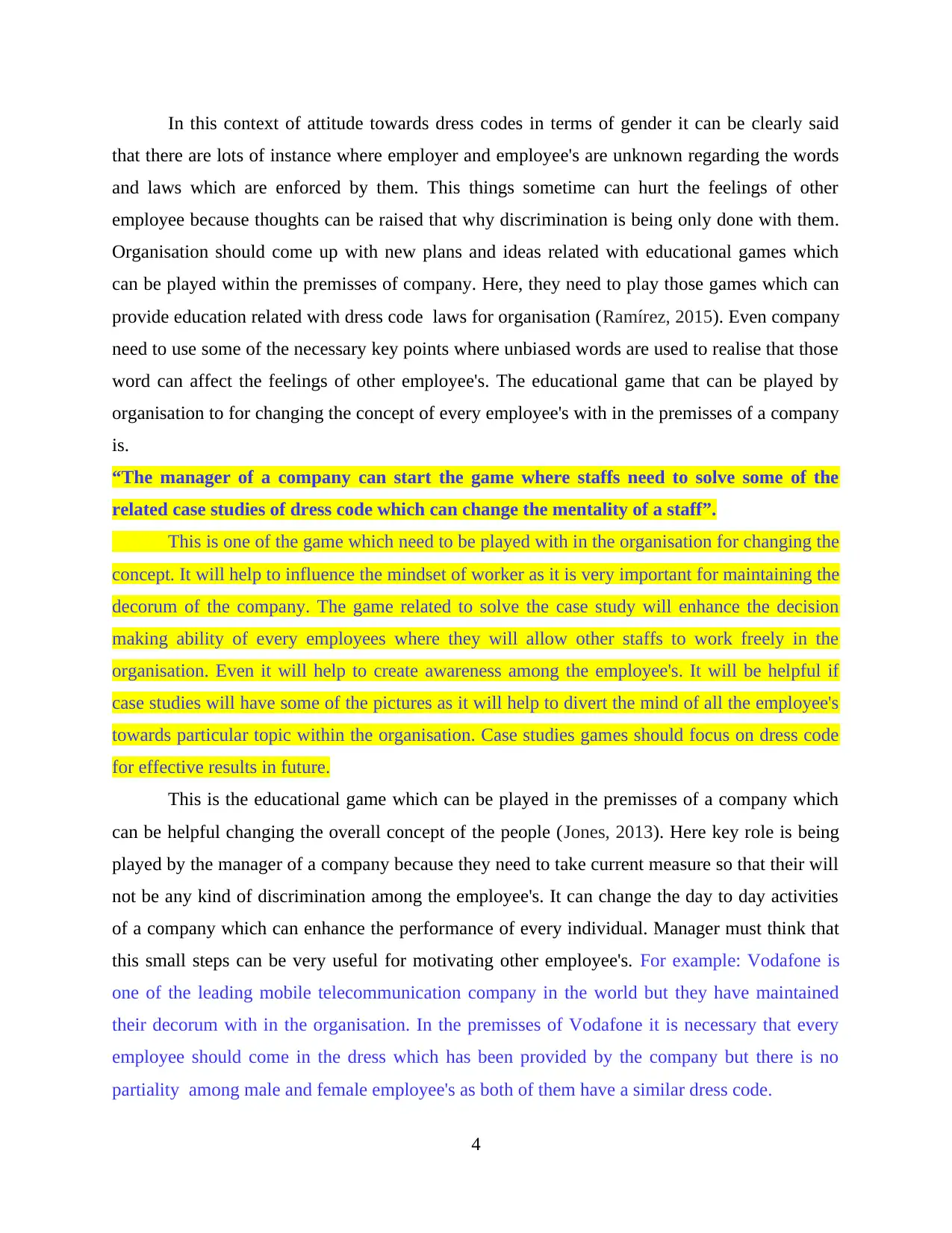
In this context of attitude towards dress codes in terms of gender it can be clearly said
that there are lots of instance where employer and employee's are unknown regarding the words
and laws which are enforced by them. This things sometime can hurt the feelings of other
employee because thoughts can be raised that why discrimination is being only done with them.
Organisation should come up with new plans and ideas related with educational games which
can be played within the premisses of company. Here, they need to play those games which can
provide education related with dress code laws for organisation (Ramírez, 2015). Even company
need to use some of the necessary key points where unbiased words are used to realise that those
word can affect the feelings of other employee's. The educational game that can be played by
organisation to for changing the concept of every employee's with in the premisses of a company
is.
“The manager of a company can start the game where staffs need to solve some of the
related case studies of dress code which can change the mentality of a staff”.
This is one of the game which need to be played with in the organisation for changing the
concept. It will help to influence the mindset of worker as it is very important for maintaining the
decorum of the company. The game related to solve the case study will enhance the decision
making ability of every employees where they will allow other staffs to work freely in the
organisation. Even it will help to create awareness among the employee's. It will be helpful if
case studies will have some of the pictures as it will help to divert the mind of all the employee's
towards particular topic within the organisation. Case studies games should focus on dress code
for effective results in future.
This is the educational game which can be played in the premisses of a company which
can be helpful changing the overall concept of the people (Jones, 2013). Here key role is being
played by the manager of a company because they need to take current measure so that their will
not be any kind of discrimination among the employee's. It can change the day to day activities
of a company which can enhance the performance of every individual. Manager must think that
this small steps can be very useful for motivating other employee's. For example: Vodafone is
one of the leading mobile telecommunication company in the world but they have maintained
their decorum with in the organisation. In the premisses of Vodafone it is necessary that every
employee should come in the dress which has been provided by the company but there is no
partiality among male and female employee's as both of them have a similar dress code.
4
that there are lots of instance where employer and employee's are unknown regarding the words
and laws which are enforced by them. This things sometime can hurt the feelings of other
employee because thoughts can be raised that why discrimination is being only done with them.
Organisation should come up with new plans and ideas related with educational games which
can be played within the premisses of company. Here, they need to play those games which can
provide education related with dress code laws for organisation (Ramírez, 2015). Even company
need to use some of the necessary key points where unbiased words are used to realise that those
word can affect the feelings of other employee's. The educational game that can be played by
organisation to for changing the concept of every employee's with in the premisses of a company
is.
“The manager of a company can start the game where staffs need to solve some of the
related case studies of dress code which can change the mentality of a staff”.
This is one of the game which need to be played with in the organisation for changing the
concept. It will help to influence the mindset of worker as it is very important for maintaining the
decorum of the company. The game related to solve the case study will enhance the decision
making ability of every employees where they will allow other staffs to work freely in the
organisation. Even it will help to create awareness among the employee's. It will be helpful if
case studies will have some of the pictures as it will help to divert the mind of all the employee's
towards particular topic within the organisation. Case studies games should focus on dress code
for effective results in future.
This is the educational game which can be played in the premisses of a company which
can be helpful changing the overall concept of the people (Jones, 2013). Here key role is being
played by the manager of a company because they need to take current measure so that their will
not be any kind of discrimination among the employee's. It can change the day to day activities
of a company which can enhance the performance of every individual. Manager must think that
this small steps can be very useful for motivating other employee's. For example: Vodafone is
one of the leading mobile telecommunication company in the world but they have maintained
their decorum with in the organisation. In the premisses of Vodafone it is necessary that every
employee should come in the dress which has been provided by the company but there is no
partiality among male and female employee's as both of them have a similar dress code.
4
⊘ This is a preview!⊘
Do you want full access?
Subscribe today to unlock all pages.

Trusted by 1+ million students worldwide
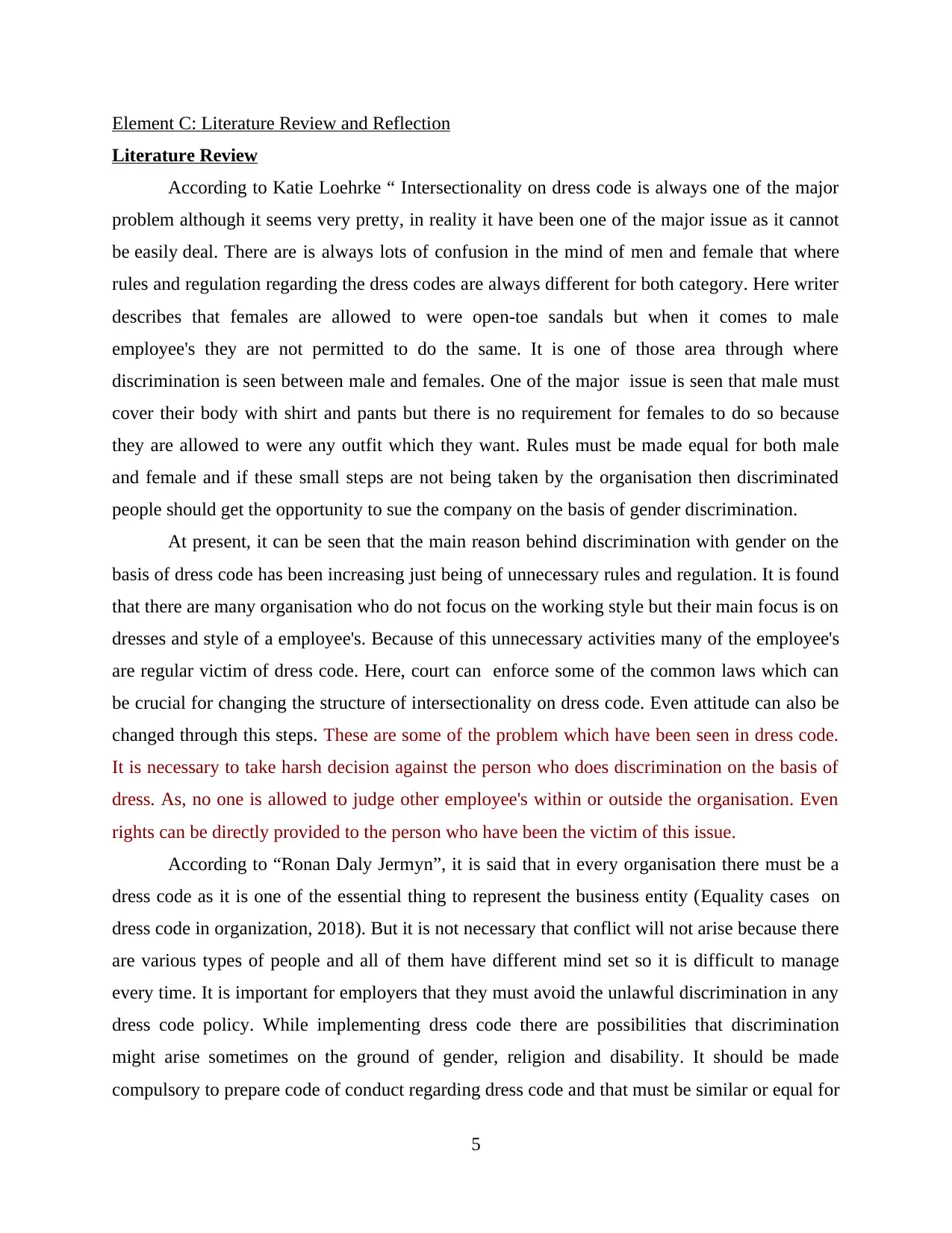
Element C: Literature Review and Reflection
Literature Review
According to Katie Loehrke “ Intersectionality on dress code is always one of the major
problem although it seems very pretty, in reality it have been one of the major issue as it cannot
be easily deal. There are is always lots of confusion in the mind of men and female that where
rules and regulation regarding the dress codes are always different for both category. Here writer
describes that females are allowed to were open-toe sandals but when it comes to male
employee's they are not permitted to do the same. It is one of those area through where
discrimination is seen between male and females. One of the major issue is seen that male must
cover their body with shirt and pants but there is no requirement for females to do so because
they are allowed to were any outfit which they want. Rules must be made equal for both male
and female and if these small steps are not being taken by the organisation then discriminated
people should get the opportunity to sue the company on the basis of gender discrimination.
At present, it can be seen that the main reason behind discrimination with gender on the
basis of dress code has been increasing just being of unnecessary rules and regulation. It is found
that there are many organisation who do not focus on the working style but their main focus is on
dresses and style of a employee's. Because of this unnecessary activities many of the employee's
are regular victim of dress code. Here, court can enforce some of the common laws which can
be crucial for changing the structure of intersectionality on dress code. Even attitude can also be
changed through this steps. These are some of the problem which have been seen in dress code.
It is necessary to take harsh decision against the person who does discrimination on the basis of
dress. As, no one is allowed to judge other employee's within or outside the organisation. Even
rights can be directly provided to the person who have been the victim of this issue.
According to “Ronan Daly Jermyn”, it is said that in every organisation there must be a
dress code as it is one of the essential thing to represent the business entity (Equality cases on
dress code in organization, 2018). But it is not necessary that conflict will not arise because there
are various types of people and all of them have different mind set so it is difficult to manage
every time. It is important for employers that they must avoid the unlawful discrimination in any
dress code policy. While implementing dress code there are possibilities that discrimination
might arise sometimes on the ground of gender, religion and disability. It should be made
compulsory to prepare code of conduct regarding dress code and that must be similar or equal for
5
Literature Review
According to Katie Loehrke “ Intersectionality on dress code is always one of the major
problem although it seems very pretty, in reality it have been one of the major issue as it cannot
be easily deal. There are is always lots of confusion in the mind of men and female that where
rules and regulation regarding the dress codes are always different for both category. Here writer
describes that females are allowed to were open-toe sandals but when it comes to male
employee's they are not permitted to do the same. It is one of those area through where
discrimination is seen between male and females. One of the major issue is seen that male must
cover their body with shirt and pants but there is no requirement for females to do so because
they are allowed to were any outfit which they want. Rules must be made equal for both male
and female and if these small steps are not being taken by the organisation then discriminated
people should get the opportunity to sue the company on the basis of gender discrimination.
At present, it can be seen that the main reason behind discrimination with gender on the
basis of dress code has been increasing just being of unnecessary rules and regulation. It is found
that there are many organisation who do not focus on the working style but their main focus is on
dresses and style of a employee's. Because of this unnecessary activities many of the employee's
are regular victim of dress code. Here, court can enforce some of the common laws which can
be crucial for changing the structure of intersectionality on dress code. Even attitude can also be
changed through this steps. These are some of the problem which have been seen in dress code.
It is necessary to take harsh decision against the person who does discrimination on the basis of
dress. As, no one is allowed to judge other employee's within or outside the organisation. Even
rights can be directly provided to the person who have been the victim of this issue.
According to “Ronan Daly Jermyn”, it is said that in every organisation there must be a
dress code as it is one of the essential thing to represent the business entity (Equality cases on
dress code in organization, 2018). But it is not necessary that conflict will not arise because there
are various types of people and all of them have different mind set so it is difficult to manage
every time. It is important for employers that they must avoid the unlawful discrimination in any
dress code policy. While implementing dress code there are possibilities that discrimination
might arise sometimes on the ground of gender, religion and disability. It should be made
compulsory to prepare code of conduct regarding dress code and that must be similar or equal for
5
Paraphrase This Document
Need a fresh take? Get an instant paraphrase of this document with our AI Paraphraser
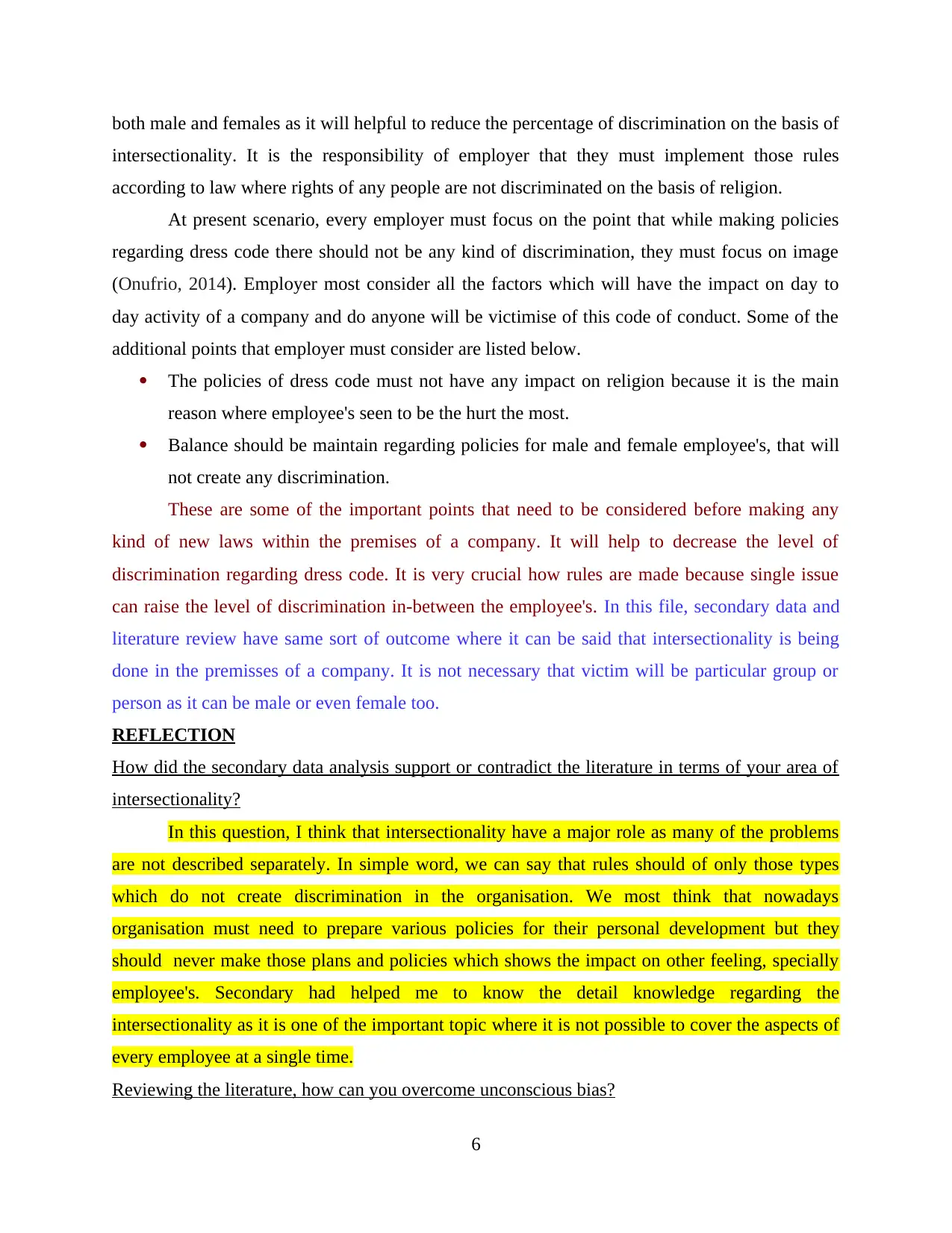
both male and females as it will helpful to reduce the percentage of discrimination on the basis of
intersectionality. It is the responsibility of employer that they must implement those rules
according to law where rights of any people are not discriminated on the basis of religion.
At present scenario, every employer must focus on the point that while making policies
regarding dress code there should not be any kind of discrimination, they must focus on image
(Onufrio, 2014). Employer most consider all the factors which will have the impact on day to
day activity of a company and do anyone will be victimise of this code of conduct. Some of the
additional points that employer must consider are listed below.
The policies of dress code must not have any impact on religion because it is the main
reason where employee's seen to be the hurt the most.
Balance should be maintain regarding policies for male and female employee's, that will
not create any discrimination.
These are some of the important points that need to be considered before making any
kind of new laws within the premises of a company. It will help to decrease the level of
discrimination regarding dress code. It is very crucial how rules are made because single issue
can raise the level of discrimination in-between the employee's. In this file, secondary data and
literature review have same sort of outcome where it can be said that intersectionality is being
done in the premisses of a company. It is not necessary that victim will be particular group or
person as it can be male or even female too.
REFLECTION
How did the secondary data analysis support or contradict the literature in terms of your area of
intersectionality?
In this question, I think that intersectionality have a major role as many of the problems
are not described separately. In simple word, we can say that rules should of only those types
which do not create discrimination in the organisation. We most think that nowadays
organisation must need to prepare various policies for their personal development but they
should never make those plans and policies which shows the impact on other feeling, specially
employee's. Secondary had helped me to know the detail knowledge regarding the
intersectionality as it is one of the important topic where it is not possible to cover the aspects of
every employee at a single time.
Reviewing the literature, how can you overcome unconscious bias?
6
intersectionality. It is the responsibility of employer that they must implement those rules
according to law where rights of any people are not discriminated on the basis of religion.
At present scenario, every employer must focus on the point that while making policies
regarding dress code there should not be any kind of discrimination, they must focus on image
(Onufrio, 2014). Employer most consider all the factors which will have the impact on day to
day activity of a company and do anyone will be victimise of this code of conduct. Some of the
additional points that employer must consider are listed below.
The policies of dress code must not have any impact on religion because it is the main
reason where employee's seen to be the hurt the most.
Balance should be maintain regarding policies for male and female employee's, that will
not create any discrimination.
These are some of the important points that need to be considered before making any
kind of new laws within the premises of a company. It will help to decrease the level of
discrimination regarding dress code. It is very crucial how rules are made because single issue
can raise the level of discrimination in-between the employee's. In this file, secondary data and
literature review have same sort of outcome where it can be said that intersectionality is being
done in the premisses of a company. It is not necessary that victim will be particular group or
person as it can be male or even female too.
REFLECTION
How did the secondary data analysis support or contradict the literature in terms of your area of
intersectionality?
In this question, I think that intersectionality have a major role as many of the problems
are not described separately. In simple word, we can say that rules should of only those types
which do not create discrimination in the organisation. We most think that nowadays
organisation must need to prepare various policies for their personal development but they
should never make those plans and policies which shows the impact on other feeling, specially
employee's. Secondary had helped me to know the detail knowledge regarding the
intersectionality as it is one of the important topic where it is not possible to cover the aspects of
every employee at a single time.
Reviewing the literature, how can you overcome unconscious bias?
6
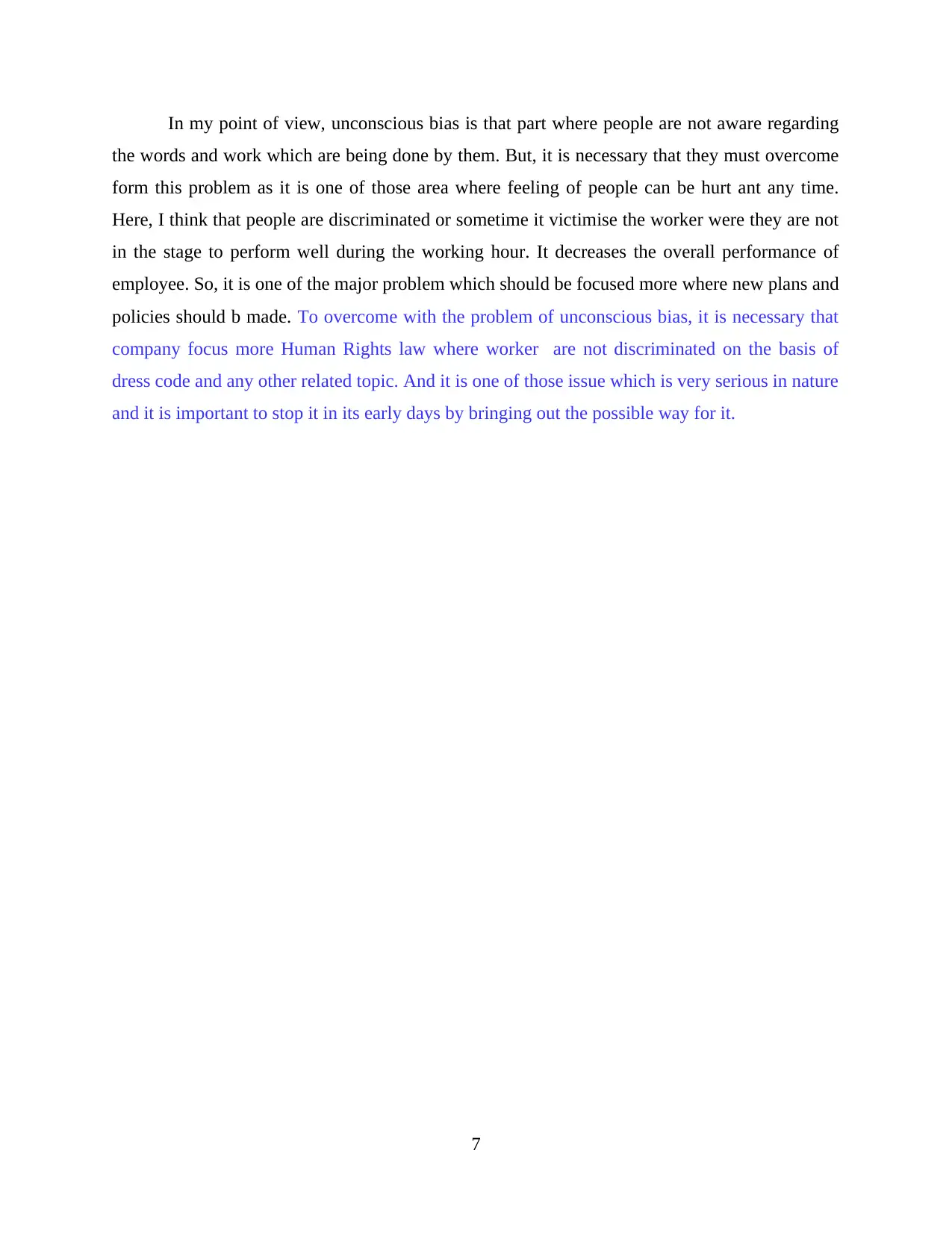
In my point of view, unconscious bias is that part where people are not aware regarding
the words and work which are being done by them. But, it is necessary that they must overcome
form this problem as it is one of those area where feeling of people can be hurt ant any time.
Here, I think that people are discriminated or sometime it victimise the worker were they are not
in the stage to perform well during the working hour. It decreases the overall performance of
employee. So, it is one of the major problem which should be focused more where new plans and
policies should b made. To overcome with the problem of unconscious bias, it is necessary that
company focus more Human Rights law where worker are not discriminated on the basis of
dress code and any other related topic. And it is one of those issue which is very serious in nature
and it is important to stop it in its early days by bringing out the possible way for it.
7
the words and work which are being done by them. But, it is necessary that they must overcome
form this problem as it is one of those area where feeling of people can be hurt ant any time.
Here, I think that people are discriminated or sometime it victimise the worker were they are not
in the stage to perform well during the working hour. It decreases the overall performance of
employee. So, it is one of the major problem which should be focused more where new plans and
policies should b made. To overcome with the problem of unconscious bias, it is necessary that
company focus more Human Rights law where worker are not discriminated on the basis of
dress code and any other related topic. And it is one of those issue which is very serious in nature
and it is important to stop it in its early days by bringing out the possible way for it.
7
⊘ This is a preview!⊘
Do you want full access?
Subscribe today to unlock all pages.

Trusted by 1+ million students worldwide
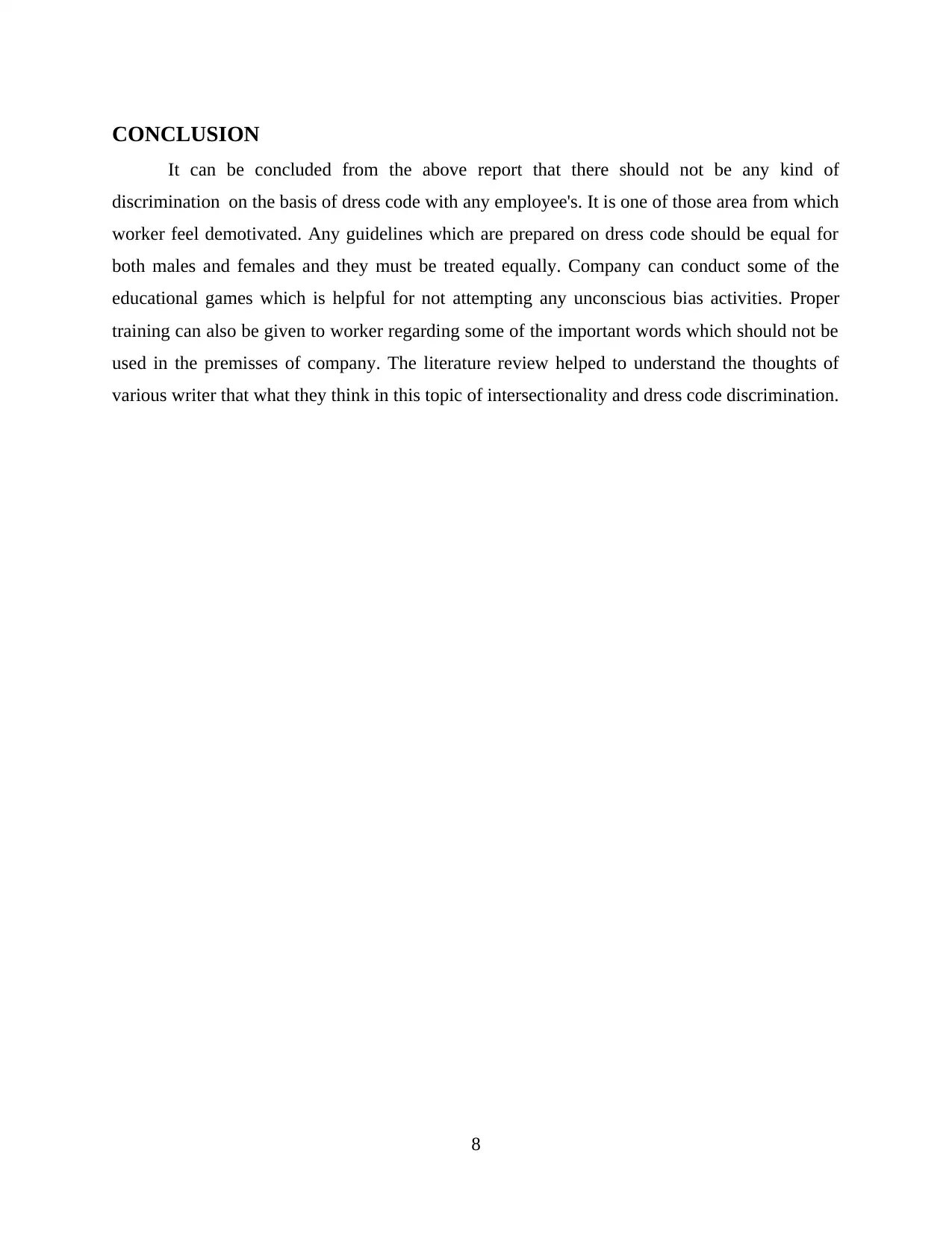
CONCLUSION
It can be concluded from the above report that there should not be any kind of
discrimination on the basis of dress code with any employee's. It is one of those area from which
worker feel demotivated. Any guidelines which are prepared on dress code should be equal for
both males and females and they must be treated equally. Company can conduct some of the
educational games which is helpful for not attempting any unconscious bias activities. Proper
training can also be given to worker regarding some of the important words which should not be
used in the premisses of company. The literature review helped to understand the thoughts of
various writer that what they think in this topic of intersectionality and dress code discrimination.
8
It can be concluded from the above report that there should not be any kind of
discrimination on the basis of dress code with any employee's. It is one of those area from which
worker feel demotivated. Any guidelines which are prepared on dress code should be equal for
both males and females and they must be treated equally. Company can conduct some of the
educational games which is helpful for not attempting any unconscious bias activities. Proper
training can also be given to worker regarding some of the important words which should not be
used in the premisses of company. The literature review helped to understand the thoughts of
various writer that what they think in this topic of intersectionality and dress code discrimination.
8
Paraphrase This Document
Need a fresh take? Get an instant paraphrase of this document with our AI Paraphraser
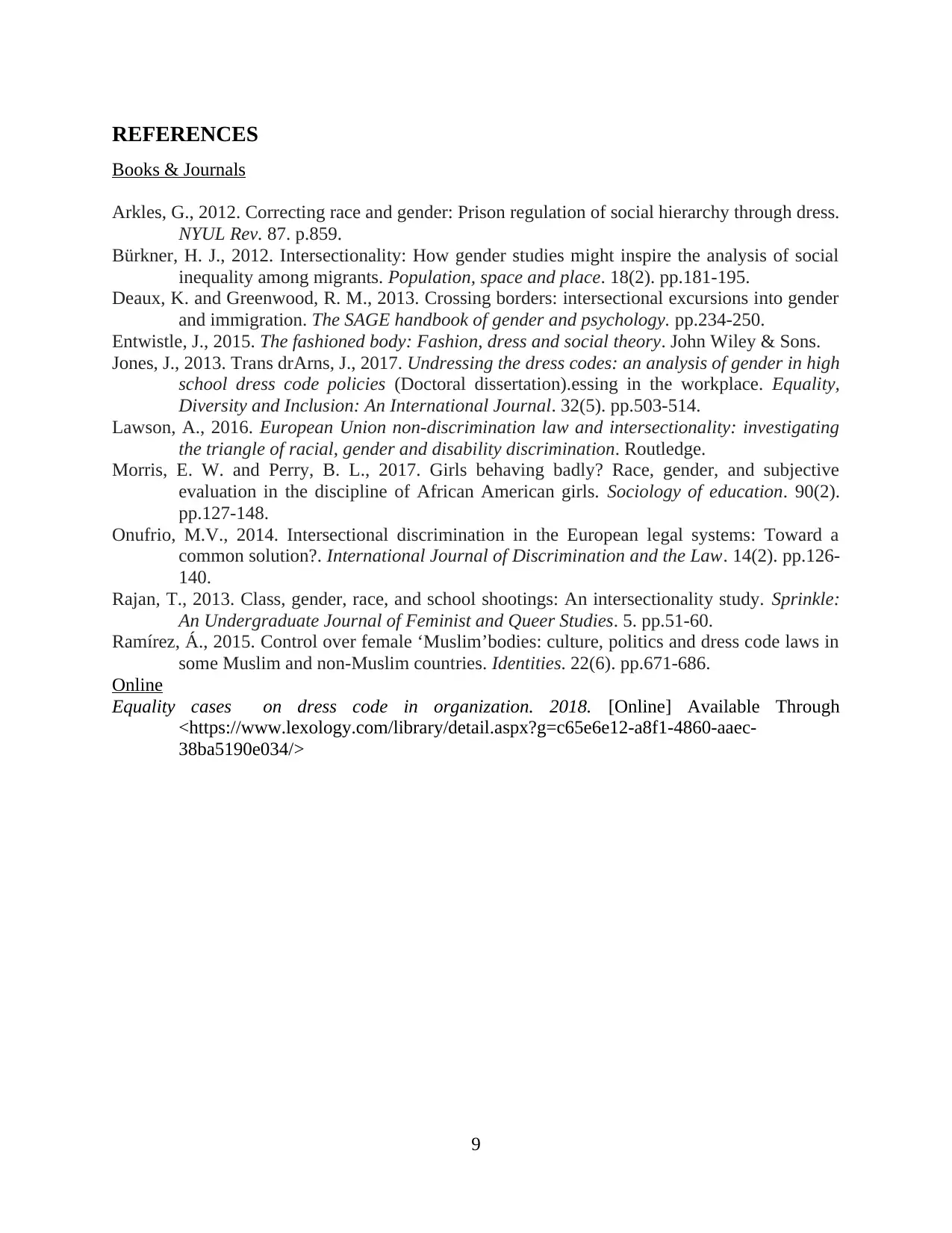
REFERENCES
Books & Journals
Arkles, G., 2012. Correcting race and gender: Prison regulation of social hierarchy through dress.
NYUL Rev. 87. p.859.
Bürkner, H. J., 2012. Intersectionality: How gender studies might inspire the analysis of social
inequality among migrants. Population, space and place. 18(2). pp.181-195.
Deaux, K. and Greenwood, R. M., 2013. Crossing borders: intersectional excursions into gender
and immigration. The SAGE handbook of gender and psychology. pp.234-250.
Entwistle, J., 2015. The fashioned body: Fashion, dress and social theory. John Wiley & Sons.
Jones, J., 2013. Trans drArns, J., 2017. Undressing the dress codes: an analysis of gender in high
school dress code policies (Doctoral dissertation).essing in the workplace. Equality,
Diversity and Inclusion: An International Journal. 32(5). pp.503-514.
Lawson, A., 2016. European Union non-discrimination law and intersectionality: investigating
the triangle of racial, gender and disability discrimination. Routledge.
Morris, E. W. and Perry, B. L., 2017. Girls behaving badly? Race, gender, and subjective
evaluation in the discipline of African American girls. Sociology of education. 90(2).
pp.127-148.
Onufrio, M.V., 2014. Intersectional discrimination in the European legal systems: Toward a
common solution?. International Journal of Discrimination and the Law. 14(2). pp.126-
140.
Rajan, T., 2013. Class, gender, race, and school shootings: An intersectionality study. Sprinkle:
An Undergraduate Journal of Feminist and Queer Studies. 5. pp.51-60.
Ramírez, Á., 2015. Control over female ‘Muslim’bodies: culture, politics and dress code laws in
some Muslim and non-Muslim countries. Identities. 22(6). pp.671-686.
Online
Equality cases on dress code in organization. 2018. [Online] Available Through
<https://www.lexology.com/library/detail.aspx?g=c65e6e12-a8f1-4860-aaec-
38ba5190e034/>
9
Books & Journals
Arkles, G., 2012. Correcting race and gender: Prison regulation of social hierarchy through dress.
NYUL Rev. 87. p.859.
Bürkner, H. J., 2012. Intersectionality: How gender studies might inspire the analysis of social
inequality among migrants. Population, space and place. 18(2). pp.181-195.
Deaux, K. and Greenwood, R. M., 2013. Crossing borders: intersectional excursions into gender
and immigration. The SAGE handbook of gender and psychology. pp.234-250.
Entwistle, J., 2015. The fashioned body: Fashion, dress and social theory. John Wiley & Sons.
Jones, J., 2013. Trans drArns, J., 2017. Undressing the dress codes: an analysis of gender in high
school dress code policies (Doctoral dissertation).essing in the workplace. Equality,
Diversity and Inclusion: An International Journal. 32(5). pp.503-514.
Lawson, A., 2016. European Union non-discrimination law and intersectionality: investigating
the triangle of racial, gender and disability discrimination. Routledge.
Morris, E. W. and Perry, B. L., 2017. Girls behaving badly? Race, gender, and subjective
evaluation in the discipline of African American girls. Sociology of education. 90(2).
pp.127-148.
Onufrio, M.V., 2014. Intersectional discrimination in the European legal systems: Toward a
common solution?. International Journal of Discrimination and the Law. 14(2). pp.126-
140.
Rajan, T., 2013. Class, gender, race, and school shootings: An intersectionality study. Sprinkle:
An Undergraduate Journal of Feminist and Queer Studies. 5. pp.51-60.
Ramírez, Á., 2015. Control over female ‘Muslim’bodies: culture, politics and dress code laws in
some Muslim and non-Muslim countries. Identities. 22(6). pp.671-686.
Online
Equality cases on dress code in organization. 2018. [Online] Available Through
<https://www.lexology.com/library/detail.aspx?g=c65e6e12-a8f1-4860-aaec-
38ba5190e034/>
9
1 out of 11
Related Documents
Your All-in-One AI-Powered Toolkit for Academic Success.
+13062052269
info@desklib.com
Available 24*7 on WhatsApp / Email
![[object Object]](/_next/static/media/star-bottom.7253800d.svg)
Unlock your academic potential
Copyright © 2020–2025 A2Z Services. All Rights Reserved. Developed and managed by ZUCOL.





